Learn how to turn a piece of stretchy fabric into a custom pair of leggings, made to fit.
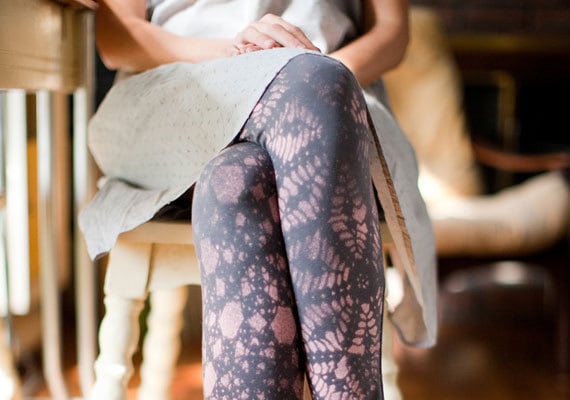
I adore leggings. I live in leggings. I always wish I had more leggings: colored ones, printed ones, stripey ones, long cozy woolly ones in winter, and shorter lightweight cotton ones in summer. I wear them under dresses or tunics, I wear them to the gym, I lounge and sleep in them. As a clothing designer, I’m glad I can make my own, because when I look around I don’t see nearly enough options out there in fun colors, prints, and natural fibers. Today I’m going to show you that you can make your own leggings, too!
You’ll need to measure yourself, draft a pattern, get some stretchy knit fabric, and stitch it up. This isn’t a difficult project, but I’m assuming you’re at least a competent beginner sewer. Let’s get started!
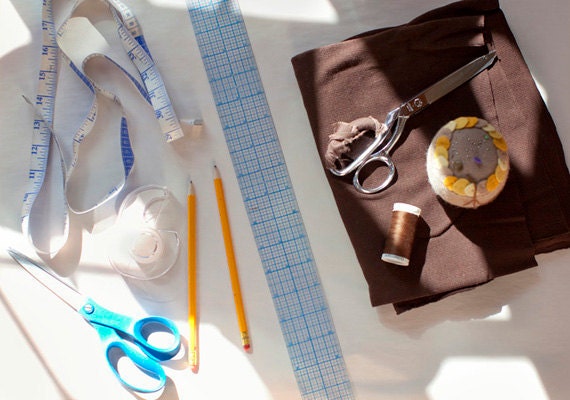
Materials You’ll Need:
For the pattern:
- Paper to make the pattern. Get a pad or roll; bigger is better. (I like an 18 x 24” pad of drawing paper.)
- Pencil and eraser
- Scissors (for cutting paper)
- Tape measure
- Ruler (clear 18” x 2” sewing ruler is best)
- Clear tape
- About 1 ½ yards of nice stretchy knit fabric, like cotton/Lycra jersey.
- About 1 ½ yards of cheaper stretchy knit fabric, like cotton/Lycra jersey (for the muslin).
- All-purpose thread to match.
- Pins
- Scissors (for fabric)
- Sewing machine
You’ll need the following measurements:
- Length
- Half Waist (Waist divided by 2)*
- Thigh Circumference*
- Knee Circumference*
- Ankle Circumference*
- Front Rise Height
- Back Rise Height
- Distance from Thigh to Knee
- Distance from Knee to Ankle
Length: This is really a design decision, but it will also relate to your body. Hold the tape measure at your side, where you’d like the waist of the leggings to sit (anywhere from waist to hip), and drop it down to your ankle. A full-length mirror should help you see the measurement of your desired length. If in doubt, I recommend going an inch or two longer. You can always shorten!
Half Waist (divided by 2)*: Measure around your waist, at the point where you want the top of the leggings to sit (and where you measured your length from). If this is more like your hip, that’s fine! Just measure yourself there. Then divide this number by 2, for your half waist.
Thigh Circumference*: Measure around the full circumference of one thigh, at its highest point (just below the crotch).
Knee Circumference*: Measure around one knee.
Ankle Circumference*: Measure around one ankle, exactly where you want the leggings to end.
Front Rise Height: This might sound odd, but here’s the best way to get this measurement: Take your ruler and hold it between your legs, as high up as is comfortable. Be sure the ruler is parallel to the floor. Now measure up from the ruler, in a straight line, to where you want the waistline of the leggings to rest. (Note: The rise seam will be curved, but for now you just want the height, which is a straight line, so don’t measure all the way from where the inseams intersect.)
Back Rise Height: Same as Front Rise, but in the back.
Distance from Thigh to Knee: Along your side, measure from the point where you took your thigh circumference down to where you took your knee circumference.
Distance from Knee to Ankle: Same, but from knee to ankle.
Now that you have all of your body measurements, we just need to do a tiny bit of math before we begin drafting the pattern. First though, we need to talk about an important concept in patternmaking: ease. Ease is the difference in size between you and your clothes. In a woven fabric, the garment needs to be bigger than you in order for it to fit and be comfortable, because wovens generally don’t stretch. This is called positive ease. When working with knits, the garment might be bigger than you, or exactly the same, or even smaller, depending on the style. The latter is possible because knits stretch and mold to fit the body, and is called negative ease. Leggings are generally meant to cling snugly to the body, so you will want to incorporate a bit of negative ease. If you prefer a looser fit, you can skip this step.
You also need to decide on the type of knit to use. Different kinds of knits have vastly different amounts of stretch. 100% cotton sweatshirt fleece has very little stretch, while 90% cotton/10% Lycra jersey has lots of it. Lycra or Spandex (same thing, just different brands) give a fabric the ability to stretch and will also give it recovery, or the ability to return to its original shape after stretching. So if you’re not a fan of baggy knees, you might want to choose a knit with 5-10% of an elastic fiber added to it. My favorite fabrics to use for leggings are cotton/Lycra jersey or rib knits, and wool jersey or rib (with or without Lycra; wool has better recovery on its own than cotton does).
Assuming you’ll be using one of these types of knit, you can deduct 10% from each of the measurements with a * after them for negative ease. These are your four horizontal circumferences. If you are using a knit with less stretch, you might want to deduct only 5% or none at all. You will now use these adjusted numbers in place of the original measurements.
Next we need to figure out the depth of the rise seam. Take your Thigh Circumference (after deducting ease), and subtract from it your half-waist (also minus ease). Let’s call this D (for Depth). Multiply D by 1/3; this is your Front Rise Depth. Multiply D by 2/3; this is your Back Rise Depth. Write these down, you’ll need them in a little while.
So we’re ready to draft our pattern! It’ll be just one pattern piece (there’s no need for a side seam), from which you’ll cut two pieces (one for each leg) to make a pair of leggings.
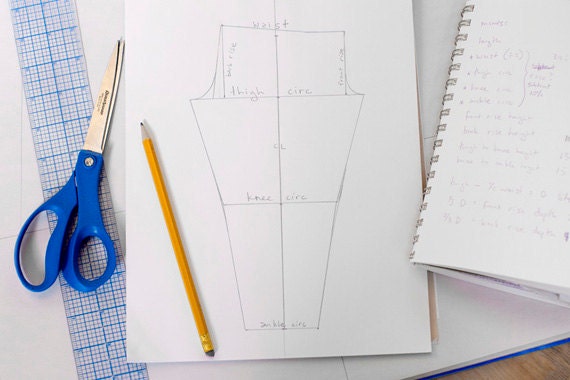 This%20is%20what%20your%20pattern%20piece%20will%20look%20like%20after%20you%20follow%20the%20steps%20below.
This%20is%20what%20your%20pattern%20piece%20will%20look%20like%20after%20you%20follow%20the%20steps%20below.Patternmaking Directions
1. To begin, you need to cut (or tape together) a piece of paper that measures at least 4” longer than your Length measurement, and at least 2” wider than your Thigh. Draw a vertical line down the center of the paper (or fold if it’s easier); all of your drafting will originate from this line. Imagine that this line will run down the side of your leg, where a side seam would be; this will be the center of the pattern, and I’ll refer to it as the Center Line (CL).
2. On CL, make a small mark about 2” down from the top edge of the paper. Then measure down the full Length measurement, and make another mark. At this mark, draw a line, perpendicular to CL, that measures your Ankle Circumference. Half of the measurement should extend from either side of CL.
3. From the Ankle, use your Knee to Ankle Height measurement to determine where to draw your Knee Circumference, also centered over CL. Draw the Knee line, perpendicular to CL.
4. Repeat this step, using your Thigh to Knee Height, to Draw the Thigh line. Connect the dots from Thigh to Knee to Ankle on each side. You will probably have a slight angle at the knee point; smooth it into a gentle curve.
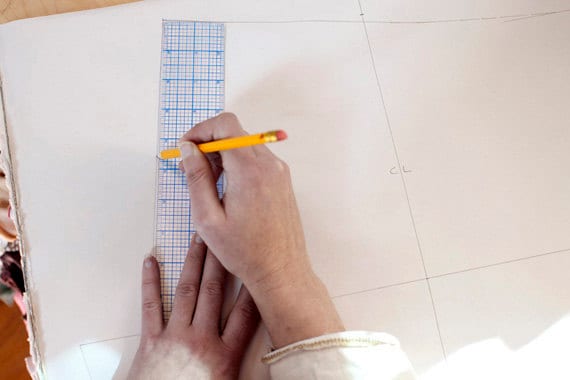
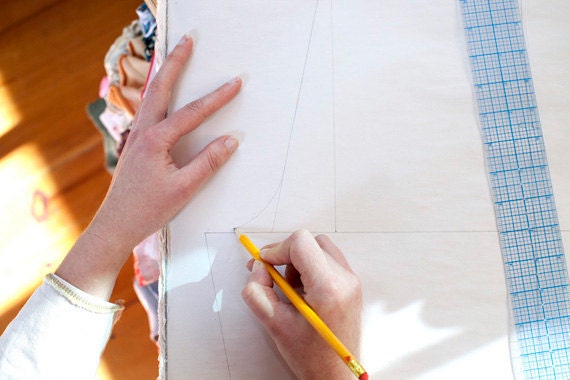
5. Now let’s work on the rise seams. On the Thigh line, measure in from the right side your Front Rise Depth, and make a mark. From this mark, draw a line upward, measuring your Front Rise Height, perpendicular to the Thigh line. From the left side, measure in your Back Rise Depth, and mark. From here, draw a perpendicular line upward, measuring your Back Rise Height. Connect the Front and Back Rise points, starting out perpendicular from the top of the Front Rise line, and gently curving up to meet the Back Rise line. This is the Waist line. Next, slope the Back Rise by holding your ruler along the Waist line, at the top of the Back Rise, and drawing a perpendicular line which intersects the Thigh line. Draw curves to fill in the lower corners of the Front and Back Rise lines.
6. All that’s left is to add seam allowance. I use ½” seam allowance on all seams except for the bottom hems, where I add a full inch for hem allowance. Draw the seam allowance around all sides of the patterns, and cut it out. CL becomes your grainline, and you can label the pattern and write the cutting instructions of Cut 2.
Now you can make a muslin, or fit sample. Try to find a cheap fabric that has similar stretch to the real fabric you plan to use. All you really need to sew are the inseams and rise seams to test the fit and make corrections. Don’t bother finishing the waistband or hems since you may want to adjust them; just remember that you will lose a little height at the waist and length at the hem when you do finish these edges in the final garment. If you see anything you want to change or adjust, pin or mark with chalk on the muslin. If you need to add fabric, such as if you want to raise the waistline, just pin on a scrap to extend the edge to where you want it. Then be sure to correct your pattern accordingly. Every body is unique, so are likely to need a few tweaks to get the fit just right. If you only make slight adjustments, you can probably jump straight to your final fabric, but if you change the pattern drastically, I’d suggest making a second muslin.
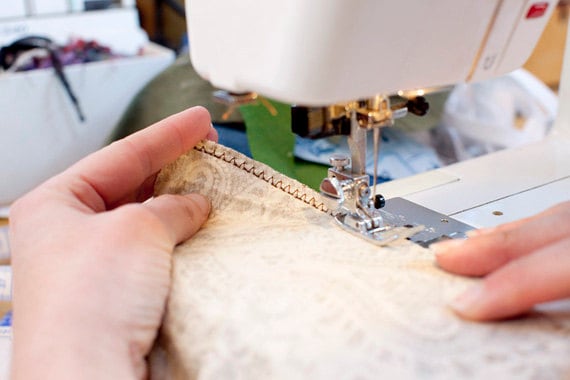
How to Sew Your Leggings
When sewing knits, you need to use a stitch that will stretch as much as your knit does, or the seam will break. Test a few options on a swatch of the same fabric, until you find a stitch that works well. I recommend using either a stretch straight stitch, or a small (I like 1.5 x 1.5mm) zigzag stitch on your sewing machine (or a serger, if you happen to have one). Fold each piece upon itself, right sides together, along the inseams, pin and sew. You’ll now have two individual leg pieces.
The edges of most knits won’t unravel, so you don’t really need to finish the seam allowances, but you might want to trim them to ¼” and either zigzag over the edges, or sew a second stretchy seam right next to the first, in case any stitches do break. Turn one leg right side out and place it inside the other, matching up the front and back rise seams and pinning together. Sew the rise as one continuous curved seam front front to back. Finish as you did the inseams, if necessary.
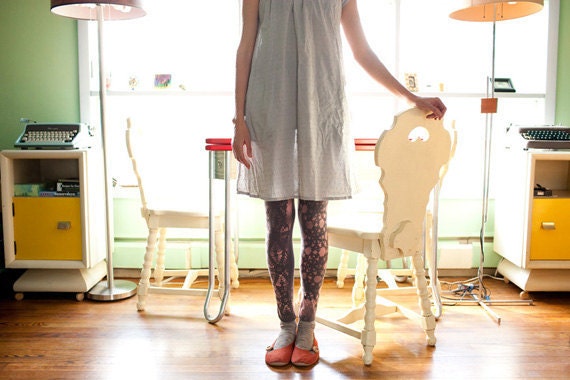
Finishing the Waistband
There are several ways you can finish the waistband. I usually use ½” elastic, cut to waist size, and seamed into a loop. Lay the elastic loop on the wrong side of the leggings waist, right at the top edge, pin and zigzag the edges together. Then turn the elastic down, so the waistline seam allowance covers it, and stitch again along the lower edge with a stretch straight stitch or a wide 3-step zig zag.
Another way is to make a folded waistband casing (with or without elastic inside) made from a separate piece of fabric. Cut the piece to your waist measurement (minus ease, plus 1” for seam allowance), by twice the desired casing width (plus 1” for seam allowance). With right sides together, sew the short seam. Sew the elastic into a loop if you’re using it, and fold the casing over it, wrong sides together. Pin the raw edges of the folded casing to the right side of the waist, and stitch around. Zigzag the three seam allowances together to finish.
To hem, turn the bottom edges under by ½”, then turn them again by another ½”, and pin. Sew with a stretch seam along the fold that is ½” from the edge.

Cal Patch is a renaissance crafter, with know-how spanning the fields of crochet, pattern-making, sewing, embroidery, dyeing, printing, spinning, and beyond. She is the author of Design-It-Yourself Clothing, writes a blog, and can can be found teaching classes around New York state (and beyond).



